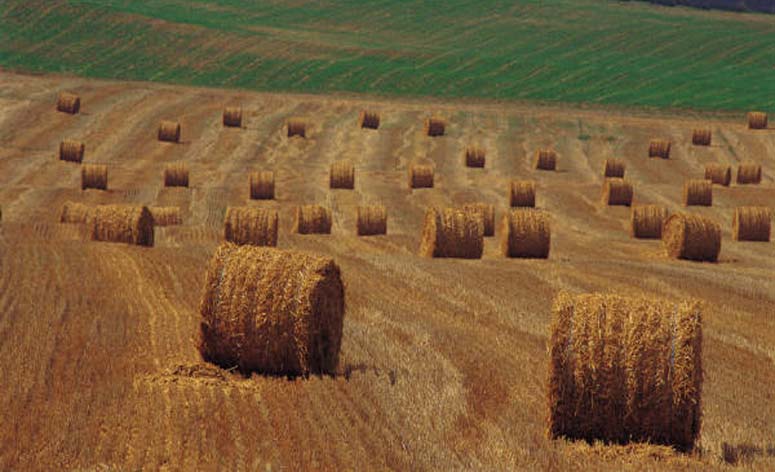
Agricultural News
Do You Know What's Growing In Your 2013 Stored Crop?
Fri, 20 Jun 2014 16:16:32 CDT

Conditions in North America have now put the 2013 stored crop, once considered at low to moderate risk for mycotoxins, at increased mold and mycotoxin growth potential, according to Alltech's recent storage analysis.
Over the past ten months, Alltech has utilized their 37+™ mycotoxin analysis program to identify the presence and levels of mycotoxins in feeds and stored feedstuffs from the 2013 harvested crop. While mycotoxins can be present in grains and forages at harvest, temperature, moisture, oxygen and crop damage during storage can create an environment where molds can produce additional mycotoxins.
According to Dr. Max Hawkins, a nutritionist with Alltech's Mycotoxin Management Team, corn silage for 2013 was at a higher yield, but there was a great deal of variation within the crop.
"All samples analyzed from September 2013 to June 2014 (123 total) had an average of 8.46 mycotoxins per sample. The predominant mycotoxins were Type B Trichothecenes, Fusaric Acid and Fumonisins," Hawkins said. "The Risk Equivalent Quantity (REQ), developed by our mycotoxin management research team, takes into account the overall risk associated with all of the mycotoxins present and was at a cautionary level for corn silage samples at harvest, but has now increased to a high risk level. These mycotoxins can affect dry matter intake, milk production, milk components, rumen function, gut and organ health and immune response."
As corn silage is a large portion of total mixed rations (TMR), the REQ has also increased as expected. For the 363 TMR samples analyzed during the same time period, each had an average of 7.6 mycotoxins, and Type B Trichothecenes, Fusaric Acid and Fumonisin were the most common. The TMR REQ for beef cattle followed a similar trend, but posed a lower risk.
"Beef cattle have a higher threshold because of lower dry matter intake and production stress as compared to a dairy cow. This does not mean that there is not a risk, just that it is less," Hawkins said. "The TMR REQ for calves showed high risk in September and has increased steadily over time. This is due to the calf's lower tolerance to mycotoxins and less mature immune status."
TMR risks include decreased dry matter intake, lower milk production, slowed growth rate, increased gut health issues and organ damage and a compromised immune response.
Alltech's Analytical Services laboratory also analyzed 159 corn samples in the 37+ survey and found an average of eight mycotoxins per sample. The main mycotoxins present included Type B Trichothecenes, Fusaric Acid and Fumonisin.
"The presence of Fusaric Acid is significant as it can act synergistically with DON (Type B Trichothecene) to magnify the effects of DON. It can also lower blood pressure which will decrease blood flow to the gut and can decrease nutrient uptake, growth and feed efficiency," Hawkins said. "The REQ values for corn have not shown the large increase over time as was seen with corn silage, but the trend is to increase."
With this information, Hawkins cautions swine producers as grow/finish pigs can have a slight decrease in growth, gut health and immune response. The risk to sows and nursery pigs is also higher due to performance demands on the sow and immune status in the young nursery pig.
Poultry have a similar risk situation. The REQ for corn to broilers and layers is at a moderate level. Decreases in feed intake, growth, egg production, egg quality, gut health and immune status can be seen over time if left uncontrolled. As with all feed ingredients, the inclusion rate of the corn will determine the mycotoxin contribution to the final diets, Hawkins said.
"The findings from Alltech's 37+ storage survey from September 2013 to June 2014 show an increase in mycotoxin risk in feedstuffs and complete feeds. This increase presents a risk to livestock health and performance," said Hawkins. "Even though some risks may be low, there are multiple mycotoxins present. Dramatic effects may not be seen but feeding multiple mycotoxins at low risk can decrease animal health and performance over time."
According to Hawkins, producers should be proactive in monitoring mycotoxin presence and levels and incorporate a mycotoxin management program.
"The main objective is to continually monitor the stored grain for temperature and moisture, to check for mold growth and analyze for mycotoxin production, prior to feeding the grain to livestock and poultry," Hawkins said. "Be aware of the effects of multiple mycotoxins, implement a mycotoxin control program and be prepared for storage management of the new crop in 2014."
WebReadyTM Powered by WireReady® NSI
Top Agricultural News
More Headlines...



















